
What is It?
The XF80mm f/2.8 R LM OIS WR is a modest telephoto macro lens with a lot of acronyms in its name. XF is the Fujifilm APS-C mount. R indicates the lens has an aperture ring. LM means the lens has a linear motor. OIS is Optical Image Stabilization. Finally, WR means that it has a weather resistant design.
At 80mm, this lens is equivalent to 120mm in full frame, or a bit longer in focal length than the "go-to" full frame macro lens. The lens is a bit optically complex for the focal length, with 16 elements in 12 groups. One of those elements is aspherical, one is Super ED, while three more are basic ED low dispersion glass. The front element has the usual fluorine coating to shed water and dust.
The focus elements are on a floating focus system. This means that the elements are not fixed in place when powered off and they are somewhat free to move within the lens, which makes a distinct and disconcerting clunking sound you simply don't expect from a lens when handling it. These focus elements are divided into two separate groups, something that's becoming more common lately in mirrorless, but historically wasn't done in DSLR lenses. Up front, the filter ring is a modest 62mm.
The lens is 5.1" (130mm) in length, and is significantly wider than that 62mm filter ring at 80mm. Weight is a significant 26.5 ounces (750g).
The lens has an aperture ring that runs from f/2.8 to f/22, but you should be aware that the lens does what a lot of macro lenses do, which is to alter focal length as you get close to 1:1 in order to avoid lens extension. That means that at 1:1 the lens is really a maximum of f/4. This means that if you set f/2.8 on the aperture ring, the camera will be showing f/2.8 as the aperture, but the effective aperture is really f/4.
As with all LM lenses, there is an A setting on the aperture ring to put the aperture control into the body controls instead of the ring. The effective aperture may still not be what you see in the viewfinder.
A 9-blade rounded diaphragm is used on the lens when stopping down.
Focus range is 9.8 inches (0.25m), but note that the lens is just over 5" (.13m) in length to start with—and the lens hood adds almost another 3", so you're going to be quite close to your subject at 1:1, and the lens hood could be blocking light (a reader points out that the lens works with the 1.4x and 2x teleconverters, which would extend working distance, but I don't have those to test). Manual focus is done by a fly-by-wire focus ring.
Focus range can be set by switch on the lens to 0.25-0.5m, 0.5m to infinity, or Full (0.25m to infinity). The optical image stabilization (OIS) system is controlled by a simple on/off switch.
The lens retails for US$1200 and is made in Japan.
Source of the reviewed lens: B&H loan
Fujifilm's Web Page for the lens
How's it Handle?
Okay, maybe it's not exactly a handling issue, but we have to talk about the floating element system. It really is disconcerting and annoying. This is made more annoying by the fact that Fujifilm doesn't warn you about this (on the box or in the instruction manual). Thus, almost everyone unaware of this aspect of the lens will unpack this lens from the box, start handling it, and immediately think they've got a clunker and need to send it back.
Well, it is a clunker, literally, but it was designed that way.
Indeed, if you take off both caps and tilt the lens up and down, you can see free floating focus elements floating.
I've not come across another lens with so distracting a design element as the floating elements in the Fujifilm 80mm. And it is distracting.
Meanwhile, the lens hood is deep. On the one hand, this is good, as it definitely keeps stray light off the front element of the lens, even more so given that the front element is small compared to the diameter of the lens and has a too-bright reflecting ring around it that could cause trouble. But note that at 1:1 you have barely an inch clearance from the front of the hood, so getting light into your subject can be troublesome at true macro distances.
Focus-by-wire is decently performed, in that Fujifilm has wisely chosen to stay on the conservative side with the ring movement's control of the focus change. At very close distances it takes quite a bit of ring movement to move focus a small amount. That means that I was able to precisely and manually focus close subjects, though it took some time to get to that spot.
How's it Perform?
Focus. I've seen others write that the lens is slow to focus. I can confirm that, but that's not quite the whole story. In general use, the lens is indeed clearly slower to focus than, say, the 16-55mm at 55mm in the same situation. You aren't going to find it fast-to-focus in general use, but it's quite usable for most subjects that aren't moving fast or erratically. Even on more static subjects you're going to see a lot of slide-to-focus in the viewfinder, though, particularly when focus distance has to shift a great amount. Moreover, on my X-H1 there's an awful lot of slide-to-focus, bounce away momentarily, then snap-back-to-the-focus-point going on in low light and low contrast situations. I'm not sure that's solely a lens issue. It seems more like a camera algorithm interacting with the lens.
Like many macro lenses, when you get really close and particularly if there's any movement in the camera or the subject, you can definitely expect focus hunting, and the lens will almost always slide to focus at very close distances. Plus when you use the full range of the lens and go from something more distant to something close, you'll also see more of the usual slide-to-focus kind of focus performance.

At this 1:1 distance, any motion of the subject or camera was causing constant refocusing, as is often the case with macro lenses. You'll note that only one filament is in focus, and only parts of a few anthers (the pollen-producing bit).
All this makes the lens a little less practical than it could be for general use. But I wouldn't dismiss it out of hand. You're just not going to be shooting quick-moving sports with this lens ;~).
Sharpness: The lens is very sharp wide open, probably what I'd call excellent, but you'll see small improvements as you stop down. So if you're looking for absolute acuity, you'd best be somewhere around f/8. That said, f/2.8 is just fine and not very far behind the best the lens is capable of.
You'll note that I didn't say anything about about center versus corners. That's an interesting story with this lens. I suspect most people will see the corners near as sharp as the center. There's a bit of meridional drift—that would be detail on the axis from center of frame to corner—but not as much as you normally see in doing MTF testing on lenses.
Technically, though, there's clear variation as we move from the center to the corner in the fine detail, the classic "dipping" MTF. Sagittal scores drop as you move from the center towards the edge, then resurge as you near the corners. Meridional scores do the same thing, but then drop slightly again as you get to the extreme corner. You can see this in Fujifilm's published MTF charts, and I see it clearly in my testing on flat subjects, too.
What's this mean? Well, contrast and sharpness are never bad on this lens, but it is variable across the frame. This means that we have some clear field curvature in the lens. Flat field subjects are going to be sharpest in the center, show some mild weakness mid frame, and become strong again towards the edges and corner.
That's a bit unusual for a macro lens. Let me rephrase that. That's unusual for those of us who are used to Nikon macro lenses, which are designed specifically for flat field capture (what Nikon calls CRC).
The good news is that the measured test numbers are never low—this lens puts up very strong MTF results across the frame—and for most subjects you're not going to notice the drifting effect of the field curvature. I noticed that one other review I encountered for this lens basically proclaimed that it was sharp in center and corner. True as far as that goes.
Linear distortion: Very good results, with extremely low pin cushion distortion. I'm not tempted to correct for what's there, even with straight lines near the edges.
Vignetting: other than wide open, where there's about two-thirds of a stop of falloff, once you stop down you can pretty much ignore it.
Chromatic aberration: The recorded numbers using the lens corrections—built-in to the Adobe converters now—are very low. Basically ignorable.
Bokeh: Very clean and simple. I don't see much in the way of complication, which is exactly how I want my macro lenses to perform. Moreover, the focus-to-out-of-focus transition looks pretty smooth and uncomplicated to me, something you might be able to see in the image below.

Final Words
This lens has two attributes that detract from its overall desirability. First, is that focus performance is on the sluggish side, particularly with large distance changes. Second, it clunks.
Seriously, that clunking is going to annoy you. You have to trust Fujifilm on this one, because when you handle the lens it's going to make noise and it's going feel like something is shifting internally (it is). But when the camera powers and directs the lens, apparently magic fingers (magnets) do their work and everything is fine. Only time will tell how durable such a floating design really is, but you'll be reminded of it often.
Optically, the lens does just what you want a modest telephoto macro to do with only a very minor quibble on how it resolves flat fields. Overall acuity is high, which is the way I want my macro lens, and it has no other obvious optical traits that might detract from the detail it is capable of resolving.
Despite the clunking, I believe I like this longer macro lens better than Fujifilm's other option, the 60mm f/2.4. Which you pick, to some degree, is going to be dependent upon what you're photographing. Personally, I wish there was a bit more difference in focal length between Fujifilm's options (e.g. 60mm and 90mm), but I'll take what they gave us.
This is one of those lenses that are self-selecting. You buy it because it's what you need. The focus performance lowers the 80mm's value as a general purpose lens somewhat, so it's really the macro folk that will gravitate towards it, and I think they'll be happy when they do.
Support this site by buying the lens from this advertiser:
